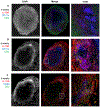IL-10 Impairs Local Immune Response in Lung Granulomas and Lymph Nodes during Early Mycobacterium tuberculosis Infection
- PMID: 31862711
- PMCID: PMC6981067
- DOI: 10.4049/jimmunol.1901211
IL-10 Impairs Local Immune Response in Lung Granulomas and Lymph Nodes during Early Mycobacterium tuberculosis Infection
Abstract
Tuberculosis (TB), caused by Mycobacterium tuberculosis, continues to be a major global health problem. Lung granulomas are organized structures of host immune cells that function to contain the bacteria. Cytokine expression is a critical component of the protective immune response, but inappropriate cytokine expression can exacerbate TB. Although the importance of proinflammatory cytokines in controlling M. tuberculosis infection has been established, the effects of anti-inflammatory cytokines, such as IL-10, in TB are less well understood. To investigate the role of IL-10, we used an Ab to neutralize IL-10 in cynomolgus macaques during M. tuberculosis infection. Anti-IL-10-treated nonhuman primates had similar overall disease outcomes compared with untreated control nonhuman primates, but there were immunological changes in granulomas and lymph nodes from anti-IL-10-treated animals. There was less thoracic inflammation and increased cytokine production in lung granulomas and lymph nodes from IL-10-neutralized animals at 3-4 wk postinfection compared with control animals. At 8 wk postinfection, lung granulomas from IL-10-neutralized animals had reduced cytokine production but increased fibrosis relative to control animals. Although these immunological changes did not affect the overall disease burden during the first 8 wk of infection, we paired computational modeling to explore late infection dynamics. Our findings support that early changes occurring in the absence of IL-10 may lead to better bacterial control later during infection. These unique datasets provide insight into the contribution of IL-10 to the immunological balance necessary for granulomas to control bacterial burden and disease pathology in M. tuberculosis infection.
Copyright © 2020 by The American Association of Immunologists, Inc.
Figures









Similar articles
-
Lymph nodes-The neglected battlefield in tuberculosis.PLoS Pathog. 2020 Aug 13;16(8):e1008632. doi: 10.1371/journal.ppat.1008632. eCollection 2020 Aug. PLoS Pathog. 2020. PMID: 32790739 Free PMC article. Review.
-
Variability in tuberculosis granuloma T cell responses exists, but a balance of pro- and anti-inflammatory cytokines is associated with sterilization.PLoS Pathog. 2015 Jan 22;11(1):e1004603. doi: 10.1371/journal.ppat.1004603. eCollection 2015 Jan. PLoS Pathog. 2015. PMID: 25611466 Free PMC article.
-
Effects of B Cell Depletion on Early Mycobacterium tuberculosis Infection in Cynomolgus Macaques.Infect Immun. 2016 Apr 22;84(5):1301-1311. doi: 10.1128/IAI.00083-16. Print 2016 May. Infect Immun. 2016. PMID: 26883591 Free PMC article.
-
Activated B cells in the granulomas of nonhuman primates infected with Mycobacterium tuberculosis.Am J Pathol. 2012 Aug;181(2):508-14. doi: 10.1016/j.ajpath.2012.05.009. Epub 2012 Jun 19. Am J Pathol. 2012. PMID: 22721647 Free PMC article.
-
Understanding the development of tuberculous granulomas: insights into host protection and pathogenesis, a review in humans and animals.Front Immunol. 2024 Dec 9;15:1427559. doi: 10.3389/fimmu.2024.1427559. eCollection 2024. Front Immunol. 2024. PMID: 39717773 Free PMC article. Review.
Cited by
-
Immune-related factors associated with pneumonia in 127 children with coronavirus disease 2019 in Wuhan.Pediatr Pulmonol. 2020 Sep;55(9):2354-2360. doi: 10.1002/ppul.24907. Epub 2020 Jul 1. Pediatr Pulmonol. 2020. PMID: 32543756 Free PMC article.
-
Immunological effects of the PE/PPE family proteins of Mycobacterium tuberculosis and related vaccines.Front Immunol. 2023 Sep 27;14:1255920. doi: 10.3389/fimmu.2023.1255920. eCollection 2023. Front Immunol. 2023. PMID: 37841250 Free PMC article. Review.
-
In silico agent-based modeling approach to characterize multiple in vitro tuberculosis infection models.PLoS One. 2024 Mar 22;19(3):e0299107. doi: 10.1371/journal.pone.0299107. eCollection 2024. PLoS One. 2024. PMID: 38517920 Free PMC article.
-
Lymph nodes-The neglected battlefield in tuberculosis.PLoS Pathog. 2020 Aug 13;16(8):e1008632. doi: 10.1371/journal.ppat.1008632. eCollection 2020 Aug. PLoS Pathog. 2020. PMID: 32790739 Free PMC article. Review.
-
Immunosuppressive Mechanisms in Brucellosis in Light of Chronic Bacterial Diseases.Microorganisms. 2022 Jun 21;10(7):1260. doi: 10.3390/microorganisms10071260. Microorganisms. 2022. PMID: 35888979 Free PMC article. Review.
References
-
- WHO. Tuberculosis Fact Sheet.
-
- Tsai MC, Chakravarty S, Zhu G, Xu J, Tanaka K, Koch C, Tufariello J, Flynn J, and Chan J. 2006. Characterization of the tuberculous granuloma in murine and human lungs: cellular composition and relative tissue oxygen tension. Cellular microbiology 8: 218–232. - PubMed
-
- Wolf AJ, Linas B, Trevejo-Nuñez GJ, Kincaid E, Tamura T, Takatsu K, and Ernst JD. 2007. Mycobacterium tuberculosis infects dendritic cells with high frequency and impairs their function in vivo. The Journal of Immunology 179: 2509–2519. - PubMed
Publication types
MeSH terms
Substances
Grants and funding
LinkOut - more resources
Full Text Sources
Medical

